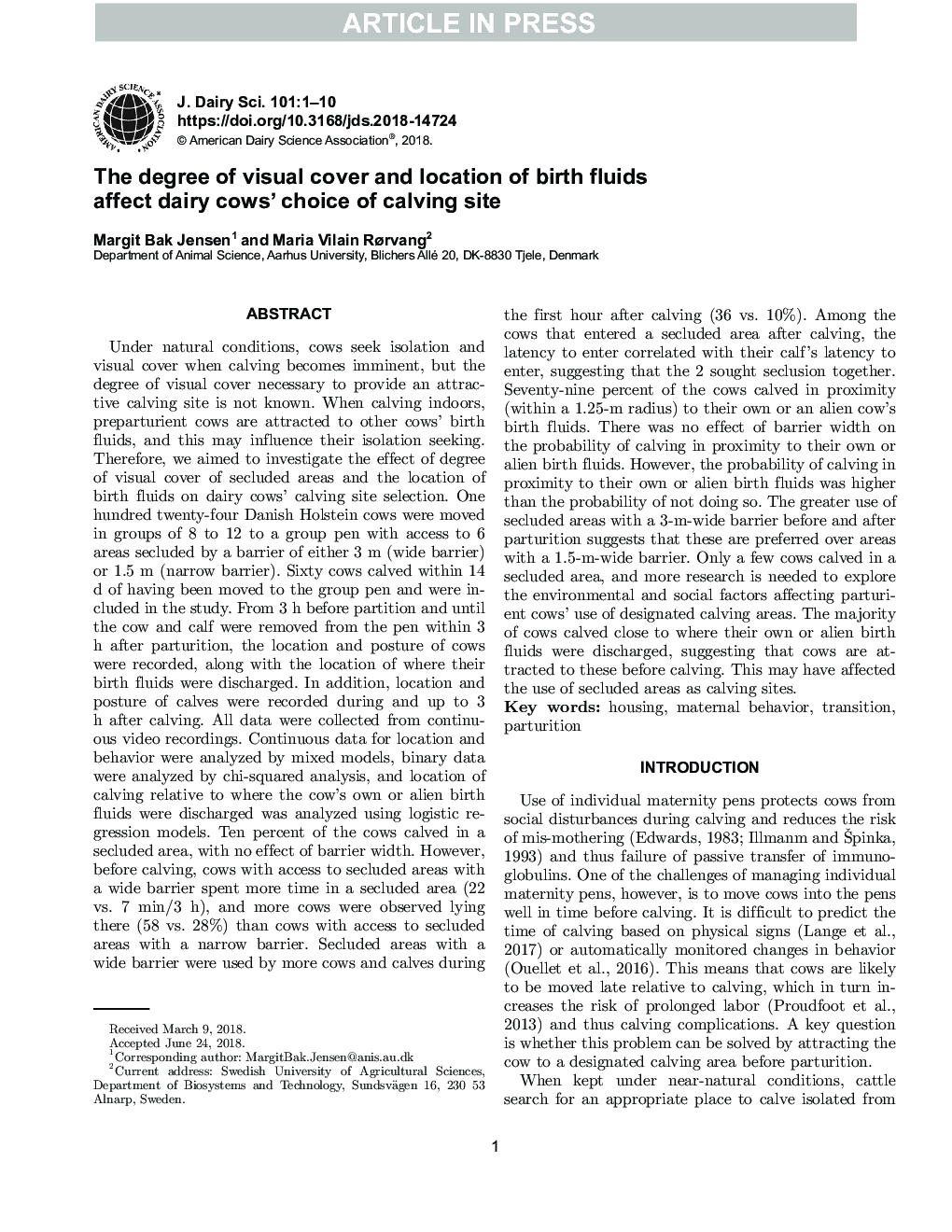| کد مقاله | کد نشریه | سال انتشار | مقاله انگلیسی | نسخه تمام متن |
|---|---|---|---|---|
| 10158106 | 1666505 | 2018 | 10 صفحه PDF | دانلود رایگان |
عنوان انگلیسی مقاله ISI
The degree of visual cover and location of birth fluids affect dairy cows' choice of calving site
ترجمه فارسی عنوان
میزان پوشش بصری و محل قرار گیری مایعات زایمان بر انتخاب گاوهای شیری بستگی دارد
دانلود مقاله + سفارش ترجمه
دانلود مقاله ISI انگلیسی
رایگان برای ایرانیان
کلمات کلیدی
مسکن، رفتار مادرانه، گذار، پیوند زدن،
موضوعات مرتبط
علوم زیستی و بیوفناوری
علوم کشاورزی و بیولوژیک
علوم دامی و جانورشناسی
چکیده انگلیسی
Under natural conditions, cows seek isolation and visual cover when calving becomes imminent, but the degree of visual cover necessary to provide an attractive calving site is not known. When calving indoors, preparturient cows are attracted to other cows' birth fluids, and this may influence their isolation seeking. Therefore, we aimed to investigate the effect of degree of visual cover of secluded areas and the location of birth fluids on dairy cows' calving site selection. One hundred twenty-four Danish Holstein cows were moved in groups of 8 to 12 to a group pen with access to 6 areas secluded by a barrier of either 3 m (wide barrier) or 1.5 m (narrow barrier). Sixty cows calved within 14 d of having been moved to the group pen and were included in the study. From 3 h before partition and until the cow and calf were removed from the pen within 3 h after parturition, the location and posture of cows were recorded, along with the location of where their birth fluids were discharged. In addition, location and posture of calves were recorded during and up to 3 h after calving. All data were collected from continuous video recordings. Continuous data for location and behavior were analyzed by mixed models, binary data were analyzed by chi-squared analysis, and location of calving relative to where the cow's own or alien birth fluids were discharged was analyzed using logistic regression models. Ten percent of the cows calved in a secluded area, with no effect of barrier width. However, before calving, cows with access to secluded areas with a wide barrier spent more time in a secluded area (22 vs. 7 min/3 h), and more cows were observed lying there (58 vs. 28%) than cows with access to secluded areas with a narrow barrier. Secluded areas with a wide barrier were used by more cows and calves during the first hour after calving (36 vs. 10%). Among the cows that entered a secluded area after calving, the latency to enter correlated with their calf's latency to enter, suggesting that the 2 sought seclusion together. Seventy-nine percent of the cows calved in proximity (within a 1.25-m radius) to their own or an alien cow's birth fluids. There was no effect of barrier width on the probability of calving in proximity to their own or alien birth fluids. However, the probability of calving in proximity to their own or alien birth fluids was higher than the probability of not doing so. The greater use of secluded areas with a 3-m-wide barrier before and after parturition suggests that these are preferred over areas with a 1.5-m-wide barrier. Only a few cows calved in a secluded area, and more research is needed to explore the environmental and social factors affecting parturient cows' use of designated calving areas. The majority of cows calved close to where their own or alien birth fluids were discharged, suggesting that cows are attracted to these before calving. This may have affected the use of secluded areas as calving sites.
ناشر
Database: Elsevier - ScienceDirect (ساینس دایرکت)
Journal: Journal of Dairy Science - Volume 101, Issue 10, October 2018, Pages 9483-9492
Journal: Journal of Dairy Science - Volume 101, Issue 10, October 2018, Pages 9483-9492
نویسندگان
Margit Bak Jensen, Maria Vilain Rørvang,
